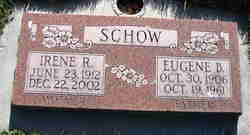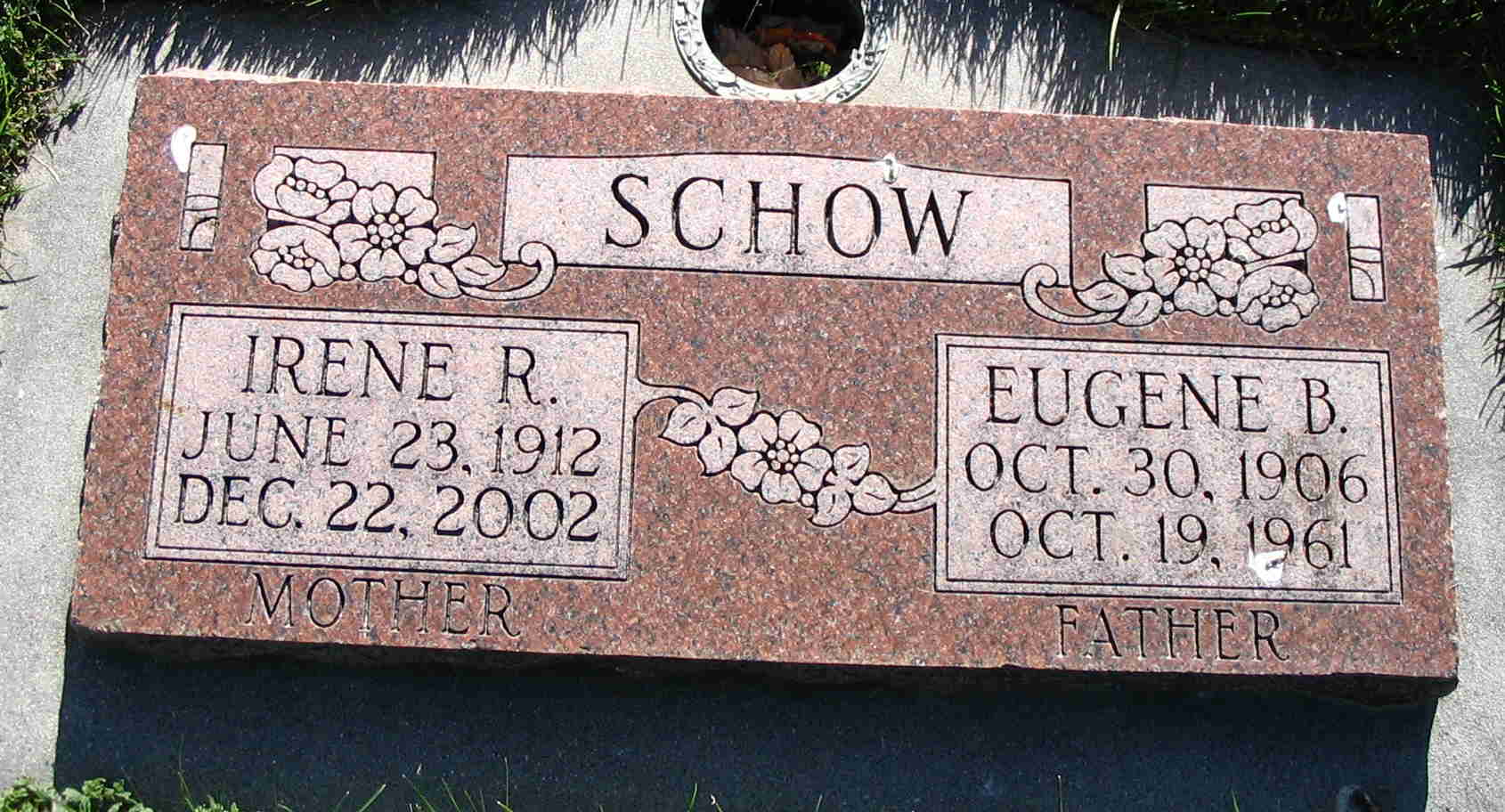Married Irene Grace Rivers, 9 Feb 1928
Children - Dorothy Jean Schow, Robert Rivers Schow, Duane Jack Schow, John Rivers Schow
Biography - Gene was very active in the Church of Jesus Christ of Latter-day Saints. During the Fall of 1928, Irene and Gene moved from Lovell to Cowley. Gene had no work so it was Irene's idea that they use the old ice house (Uncle Pete's home who had since passed away) and make them a liveable home out of it. Gene's folks thought this was a fine idea and helped them fix it. Gene filled the cracks of this log house with mud inside and out. They whitewashed the walls inside and put long strips of heavy paper on the ceiling which rattled and shook when the wind blew.
The drinking water bucket and dipper sat on a box just about three feet from the stove. In the wintertime this bucket of water and the water in the wash bowl froze to almost solid ice during the night after the cook stove fire went out. They warmed irons and wrapped them in paper or rags and took them to bed with them. They wore stockings to bed and flannel bed clothing to keep warm during the night. Grandma Schow made a fur fabric, sack like, affair that zipped around Dorothyjean's neck, and she called it a "Kitty Kin." There was no chance for her legs or arms to get out. This kept their baby warm.
They lived just three blocks too far out of town to have electricity, gas or telephone. They burned cedar wood which was gotten at Gyp Creek (9 miles away). Sometimes they had coal. The lighting was kerosene lamp. They had a large 50 gallon barrel that sat behind the kitchen stove. Gene carried large chunks of ice (4 to 6 inches thick) from the lateral nearby and chipped it into the barrel. Then, they put the boiler on the stove with a little water in it and chipped ice into it so that it was full. When it was almost boiling, we poured this over the chipped ice in the barrel. By the next day all the ice was melted, and it was ready for wash day.
They longed for a home nearer town so that they could have the modern conveniences that most people had then. After a few years of this, they rented a home just a block and half from town. They were charged $5 per month rent! Heavenly days, what more could anyone ask for. They had electric lights, gas, and a water faucet right in their back yard. Great day in the morning! Things seemed to be falling into place. Gene also began to work a little steadier by the canning factory. Gene was one of the highest paid men at the cannery and by 1941, he made 60 cents per hour. Irene made 35 cents.
In 1942, after World War 11 had been declared, they moved to Layton, Utah. They worked at HAFB-Gene as a carpenter and estimator, and Irene as a storekeeper inspector of A/C material, Material Dispatcher in the hangar and, after 1960, as personnel clerk for a section chief. Irene always quit during the summer to be home with the children so when she went back, she always tried a different job.
When the war came to an end, Irene volunteered her services to the Red Cross. Her assignment was to be at the Red Cross Canteen at HAFB every Monday to meet the big hospital ships as they landed for refueling on their way to a military hospital with their precious cargo of returning injured servicemen. When the planes landed (several each day), there was food ready for them at no expense and a cheerful smile for these men were sadly in need of understanding and some to talk to. They were war-weary, nervous and injured in so many ways. This went on for many months until the wounded were back on home ground again.
In October 1961, Gene passed away from bone cancer. Although the family had known his death was imminent for months, it was a great shock when it came. It was a relief that his suffering had come to an end.
Married Irene Grace Rivers, 9 Feb 1928
Children - Dorothy Jean Schow, Robert Rivers Schow, Duane Jack Schow, John Rivers Schow
Biography - Gene was very active in the Church of Jesus Christ of Latter-day Saints. During the Fall of 1928, Irene and Gene moved from Lovell to Cowley. Gene had no work so it was Irene's idea that they use the old ice house (Uncle Pete's home who had since passed away) and make them a liveable home out of it. Gene's folks thought this was a fine idea and helped them fix it. Gene filled the cracks of this log house with mud inside and out. They whitewashed the walls inside and put long strips of heavy paper on the ceiling which rattled and shook when the wind blew.
The drinking water bucket and dipper sat on a box just about three feet from the stove. In the wintertime this bucket of water and the water in the wash bowl froze to almost solid ice during the night after the cook stove fire went out. They warmed irons and wrapped them in paper or rags and took them to bed with them. They wore stockings to bed and flannel bed clothing to keep warm during the night. Grandma Schow made a fur fabric, sack like, affair that zipped around Dorothyjean's neck, and she called it a "Kitty Kin." There was no chance for her legs or arms to get out. This kept their baby warm.
They lived just three blocks too far out of town to have electricity, gas or telephone. They burned cedar wood which was gotten at Gyp Creek (9 miles away). Sometimes they had coal. The lighting was kerosene lamp. They had a large 50 gallon barrel that sat behind the kitchen stove. Gene carried large chunks of ice (4 to 6 inches thick) from the lateral nearby and chipped it into the barrel. Then, they put the boiler on the stove with a little water in it and chipped ice into it so that it was full. When it was almost boiling, we poured this over the chipped ice in the barrel. By the next day all the ice was melted, and it was ready for wash day.
They longed for a home nearer town so that they could have the modern conveniences that most people had then. After a few years of this, they rented a home just a block and half from town. They were charged $5 per month rent! Heavenly days, what more could anyone ask for. They had electric lights, gas, and a water faucet right in their back yard. Great day in the morning! Things seemed to be falling into place. Gene also began to work a little steadier by the canning factory. Gene was one of the highest paid men at the cannery and by 1941, he made 60 cents per hour. Irene made 35 cents.
In 1942, after World War 11 had been declared, they moved to Layton, Utah. They worked at HAFB-Gene as a carpenter and estimator, and Irene as a storekeeper inspector of A/C material, Material Dispatcher in the hangar and, after 1960, as personnel clerk for a section chief. Irene always quit during the summer to be home with the children so when she went back, she always tried a different job.
When the war came to an end, Irene volunteered her services to the Red Cross. Her assignment was to be at the Red Cross Canteen at HAFB every Monday to meet the big hospital ships as they landed for refueling on their way to a military hospital with their precious cargo of returning injured servicemen. When the planes landed (several each day), there was food ready for them at no expense and a cheerful smile for these men were sadly in need of understanding and some to talk to. They were war-weary, nervous and injured in so many ways. This went on for many months until the wounded were back on home ground again.
In October 1961, Gene passed away from bone cancer. Although the family had known his death was imminent for months, it was a great shock when it came. It was a relief that his suffering had come to an end.
Family Members
Sponsored by Ancestry
Advertisement
Advertisement















